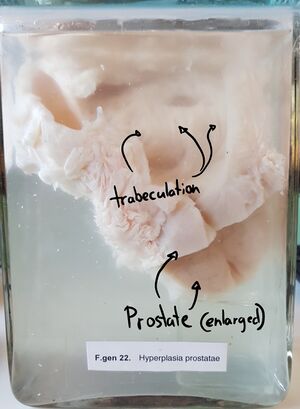20. Prostatic hyperplasia
Organ: Prostate, bladder
Description:
This prostate is a lot larger than the normal “chestnut”-size.
The mucosa of the bladder isn’t smooth but looks trabeculated.
Diagnosis: Benign prostate hyperplasia
Causes:
- See slide 16
Theory:
BPH always affects the parts of the prostate that are around the urethra, so the enlarged prostate will compress the urethra. This yields lower urinary tract symptoms, like trouble urinating.
The compressed urethra means that the muscles of the bladder must work harder to exit the urine. This causes the muscular layer of the bladder to hypertrophy, which is what causes the trabeculated appearance.
The increased bladder pressure can cause backward symptoms into the ureter, causing hydroureter or even chronic pyelonephritis and renal failure if it is not treated.

